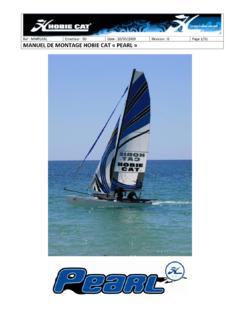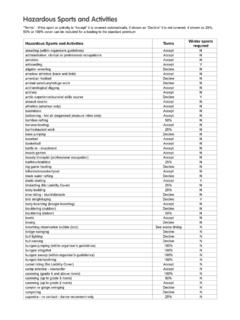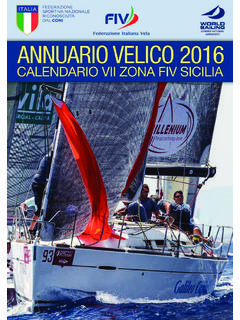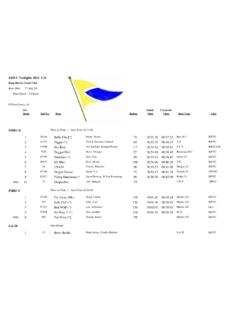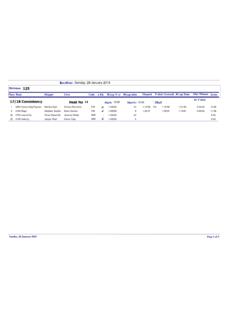Transcription of Log of sailing catamaran Eclipse
1 Log of sailingcatamaranEclipseOct 2002 Mar 2005 Plymouth UK to PanamaRichard Woods Jetti MatzkeTable of contentsSailing Mapspage 3 sailing southpage 8 Crossing the Atlanticpage 10 Barbados and the Grenadinespage 13N Caribbeanpage 17 The Virginspage 22 Puerto Rico and the Bahamaspage 26SE USApage 32 The Chesapeakepage 35 New York and New Englandpage 38 Mainepage 40 Bahamas revisitedpage 44 Cubapage 49 Belize and Guatemalapage 56 Land Mapspage 64 Land Trips page 66 Bay Islands page 96 Panamapage 103 San Blaspage 115 Appendixpage 125 Photo Albumspage 1592 sailing MapsSailing South, Plymouth to Canaries Nov 2002 Crossing the Atlantic Dec 2002 Barbados and the Grenadines Jan 20033 The N Caribbean Feb April 2003 The Virgins to Puerto Rico May 2003 Puerto Rico to the Bahamas May June 20034 The Bahamas June 2003SE USA July 20035 Chesapeake to Maine and back Jul Sept 2003 Bahamas revisited and Cuba Jan Feb 20046 Belize, Guatemala and Bay Islands March Nov 2004 Bay Islands, Vivorillo Cays, Providencia, Panama Dec 20047 sailing South November 2002I am writing this in the Canary Islands, about 1800 miles from Plymouth, and I seewe ve now been away for exactly 4 weeks.
2 It s probably no surprise to anyone to learnthat leaving the UK at the end of October is not a good idea! During our crossing of the Bay of Biscay we had over 40 knots of wind, but since Ihave a remote control autopilot we can sit below on watch and still see out all round,which in the cold and rain was great! We arrived in N Spain after a stop in S Brittanyand spent a few days cruising (in the rain and to windward - of course!) round thecoast to Bayonna. I like Bayonna, but we only had time for a couple of days there and then we left andmotored/sailed to Lisbon and got in just before the gales that partly destroyed theRoute de Rhum fleet. The highlight of the trip so far was beating an Outremer 43catamaran to windward over a 25 mile sail. We got into the next port over 1 hourahead. The owner had previously said he bought his boat because it was so quick towindward!
3 We had to wait a few days for the wind to moderate before leaving Lisbon. But evenso the seas were still high (4m plus) and there were frequent squalls. So we decided tomiss out Madeira and head straight to the Canaries. We did over 190 miles the firstday, but then the wind dropped and we motored for 200 but finished the tripwith a good sail into Grasciosa. This is a nice laid-back little island with a smallfishing village straight out of a spaghetti western, Clint Eastwood round every corner!Then it was on to Arecife, where we saw a few catamarans in Porto Noas, but we onlystayed there a day as west(!!)winds were forecast. And then to Fuerterventura and avery bumpy entrance through the surf. In fact this was the scariest part of the trip so far. We d avoided the big breakingwaves OK and were lining up for the harbour entrance.
4 I d just lowered the mainsailand we were motorsailing under jib. Ahead was a 9m monohull, while a 12m powerboat had just left the harbour. Then, about 200m from the entrance we saw to our8horror a wall of water rising up beside us. We turned almost 45 deg to the wave butthe top broke over us. In fact the whole wave went over the top of the boom( above the water). We got rather wet!! No damage except a shaving mirrorbroke, but of course as I have a cruising boat I have a big is a wall of water? I d guess it was 4m high plus breaking crest. The boatheeled maybe 20 degrees on the wave slope and then we just carried on I wasn t in the monohull, as that would have been rolled, the power boat wouldhave been s the first time I ve ever had a big wave break like that when sailing on a gave me a lot of confidence in the Eclipse and in catamarans in general.
5 Next day we sailed to windward in the rain to Las Palmas. Two things that neverhappen in the Canaries are: 1) rain - (its rained every day bar one since we ve beenhere) 2) west winds. The ARC started yesterday in a flat calm, then last night they hada W gale. We met up with Frank Schernikau on his 9m Skua - Swim 2 Birds- he s moored justbehind us and had arrived in Las Palmas from Germany having sailed here viaMorocco. Then he's also on off across the Atlantic, mind you, he s a tough skilledsailor - he once sailed a Hobie cat round Denmark - so in comparison he finds hisSkua quite the Atlantic December 2002 Pip Patterson from the Multihull Centre joined us in Tenerife on the 29th morning, heavily loaded, we left with a good F7 blowing, so ran downwindunder just the genoa (sometimes even that was reefed). But that didn't prevent us fromregularly doing 14 knots on the GPS with a peak of (I prefer to rely on the GPSreading as at speed the log is in aerated water and often over-reads) The wind slowly moderated, so over the next couple of days we hoisted first a reefedmainsail, then full main and then changed to spinnaker - but then the wind stopped,never to return.
6 For the next 2000 miles the wind stayed light, rarely reaching 15 knotsapparent, and was usually under 10. Before leaving we'd agreed that we'd take the spinnaker down at night, but racinghabits diehard and it wasn't long before Pip and I were changing from the small to thebig spinnaker at sailing with 3 on board meant we kept watches of 3 on and 6 off which made thesailing very easy and usually even I could sleep for 4 hours at a time. We hand steeredfor about 1 hour leaving Tenerife, then the autopilot went on, not to be turned off untilwe arrived off Port St Charles marina in Barbados. In such gentle conditions one doesn't spend much time actually sailing . It s quite astrange feeling to be reading or sleeping and realise that the boat is sailing along byitself, quite unaided. So we had plenty of free time. While Corley studied Spanish, Pip and I tried improving our rusty astro navigation.
7 Itwas a bit difficult as the 2002 almanac was in my (now broken) computer - but withthe GPS we did, of course, know exactly where we were - which helped! We managedgood noon sights, but using Polaris gave slightly random results, as we didn't have2002 correction values. A slight aside here, even uncorrected Polaris gives ones latitude within about 20 mileswith no calculation at all. Landlubbers tend to think that one navigates by the sun, infact the ancient sailors of all cultures used to navigate by the stars as its so mucheasier to find ones position with them with no need of complex tables or , as we sailed south and west the weather slowly improved, but we stillneeded foul weather jackets at night even 700 miles from Barbados. Clearly its notjust latitude that is important. As one sails west the sea has had longer to warm up andthat makes a big difference.
8 (Here in Carlisle Bay the sea temperature is 28C/82F) 200 miles from Barbados we spotted a sail on the horizon ahead. It could have comefrom anywhere, and have a crew of any nationality, but it turned out to be a Nicholson35 from Cargreen, only 5 miles from my own mooring in Millbrook! We had a chat,and took photos of each other. That evening they were hull down 150 miles to go it was clear that we wouldn't arrive in daylight. Apart from theobvious dangers of arriving at a strange landfall at night we also wanted to arriveduring normal customs office hours, so decided on an arrival time of 0900. I have often done a timed run-in at a race start, but never one that lasted 15 hours! TheGPS helped, we kept adjusting our speed by reefing so that the GPS always gave 0900as the ETA. Even so we were pretty pleased with ourselves when we tied up to thearrival pontoon at 0901, 50 days after leaving England.
9 Of course, we then had to wait3 1/2 hours for the customs to arrive - but hey we're in the Caribbean now! 11 Even now, looking back after only a few days at anchor, the days seemed to havemerged one into the other. Our abiding memories are of the usual trade wind stuff:-flying fish, dolphins, sunsets, moonlight you can read by, and a long long I think the thing that has pleased me the most is that nothing broke andEclipse needs no maintenance, despite having now sailed over 8000 miles. Despite a relatively slow passage, we were all very impressed at how Eclipse sailed inlight winds. With little more than ripples on the water, and certainly no white horses,we'd still be doing a steady knots. So there we must leave Eclipse , basking in the warm sunshine and clear waters ofCarlisle Bay, Bridgetown, 18 days after leaving the and the Grenadines January 2003 Life is full of strange coincidences, quite spooky really.
10 While in Barbados we wereinvited to a party on the Sail Training Association brig Stavros S Niarchos which hadalso just made the Atlantic crossing. There were about 40 trainees on board, plus 6full time crew. Climbing on board the first person I met was Jim Dickins, whosefather keeps his Strider Club next to my mooring at the Multihull Centre! Next I met a"gap year" couple, Leo and Kate. Leo's father's boat is currently also ashore inMillbrook while Kate is a member of Cargreen YC (remember the Nic 35 we met inmid Atlantic? - same club) I found the Stavros a fascinating boat. Although only twoyears old it had been built on traditional lines - no winches or hydraulics. Barbados is the third most densely populated country in the world, which is quite ashock when you've been at sea for three weeks. Also quite a shock for those anchoredin Carlisle Bay was the noise!
